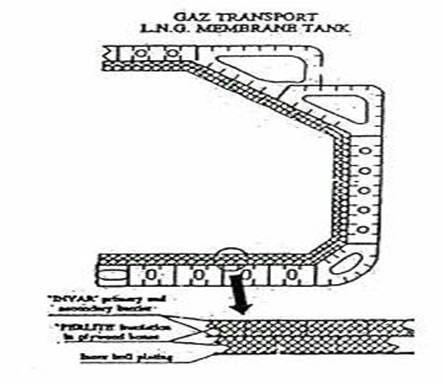Question
(a) With reference to the membrane tanks for
the carriage of liquefied gas at very low
temperatures:
(i)
Describe with the aid of a sketch ONE method of building up the
insulation;
(ii) State with reasons the alloy which is
used for the membrane;
(b) Describe with the aid of a sketch how
tanks are located and supported
Longitudinally
Transversely
Explain why a secondary barrier is installed
Answer.
(The answer is basic upon the 'Gas Transport' system)
(a)(i) The inner
hull has plywood boxes, filled with granulated periite insulation,
attached in two layers. An invar secondary
barrier is fitted between the layers, and a primary
invar barrier separates the gas from the insulation
(ii) Membrane systems must have a complete secondary
barrier to ensure integrity. The membrane material is very thin (0.5 to 1.2mm)
and must be capable of coping with the thermal expansion/contraction involved
with a very low temperature cargo. This is achieved by use of a material with a
very low coefficient of thermal expansion, (e.g, INVAR steel - 36%Ni steel).

(b) These tanks may also be referred to as
'independent' or 'self, supporting'. They do not form part o the ships hull and
do not contribute to the strength of the ship. They can be spherical,
cylindrical or prismatic in shape. Prismatic tanks are stiffened internally
by wash bulkheads, webs, girders and stiffeners, in a similar manner to oil
tankers.
Whilst the tanks are independent of the ships
structure, the tanks must resist the dynamic forces imposed by the ship motions
and this is achieved by 'chocks' such as: support chocks, anti-roll chocks,
anti-pitch chocks and anti-lift (float) chocks.
The chocks must also be a thermal barrier between the
hull and the cargo and may be wood (plywood) or plastic (permali).

Explain why a secondary barrier is installed
Secondary barriers are required if the minimum temperature is less than -10°C. Thus, in the event of leakage from the primary container, the liquid or vapour is contained for a period of up to 15 days. If the minimum temperature is higher than -50°C, the ship's hull may be used as a secondary barrier if constructed of Arctic D steel or equivalent. Independent secondary barriers may be of nickel steel, aluminium or plywood as long as they can perform their function.